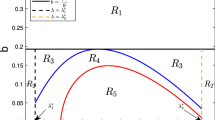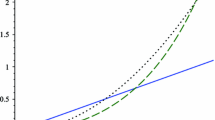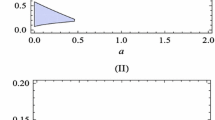Abstract
Some quantities in reaction-diffusion models from cellular biology or ecology depend on the spatial average of density functions instead of local density functions. We show that such nonlocal spatial average can induce instability of constant steady state, which is different from classical Turing instability. For a general scalar equation with spatial average, the occurrence of the steady state bifurcation is rigorously proved, and the formula to determine the bifurcation direction and the stability of the bifurcating steady state is given. For the two-species model, spatially non-homogeneous time-periodic orbits could arise due to spatially non-homogeneous Hopf bifurcation from the constant equilibrium. Examples from a nonlocal cooperative Lotka-Volterra model and a nonlocal Rosenzweig-MacArthur predator-prey model are used to demonstrate the bifurcation of spatially non-homogeneous patterns.










Similar content being viewed by others
References
Altschuler, S.J., Angenent, S.B., Wang, Y., Wu, L.F.: On the spontaneous emergence of cell polarity. Nature 454(7206), 886–889 (2008)
Britton, N.F.: Aggregation and the competitive exclusion principle. J. Theoret. Biol. 136(1), 57–66 (1989)
Casten, R.G., Holland, C.J.: Instability results for reaction diffusion equations with Neumann boundary conditions. J. Differ. Equ. 27(2), 266–273 (1978)
Chen, S.S., Shi, J.P.: Stability and Hopf bifurcation in a diffusive logistic population model with nonlocal delay effect. J. Differ. Equ. 253(12), 3440–3470 (2012)
Chen, S.S., Shi, J.P., Wei, J.J.: Time delay-induced instabilities and Hopf bifurcations in general reaction-diffusion systems. J. Nonlinear Sci. 23(1), 1–38 (2013)
Chen, S.S., Shi, J.P., Wei, J.J.: Bifurcation analysis of the Gierer-Meinhardt system with a saturation in the activator production. Appl. Anal. 93(6), 1115–1134 (2014)
Chen, S.S., Wei, J.J., Yang, K.Q.: Spatial nonhomogeneous periodic solutions induced by nonlocal prey competition in a diffusive predator-prey model. Int. J. Bifur. Chaos Appl. Sci. Engrg. 29(4):1950043, 19 (2019)
Chen, S.S., Yu, J.S.: Stability and bifurcation on predator-prey systems with nonlocal prey competition. Discrete Contin. Dyn. Syst. 38(1), 43–62 (2018)
Chen, X.F., Hambrock, R., Lou, Y.: Evolution of conditional dispersal: a reaction-diffusion-advection model. J. Math. Biol. 57(3), 361–386 (2008)
Chen, X.F., Lam, K.-Y., Lou, Y.: Dynamics of a reaction-diffusion-advection model for two competing species. Discrete Contin. Dyn. Syst. 32(11), 3841–3859 (2012)
Cosner, C., Lou, Y.: Does movement toward better environments always benefit a population? J. Math. Anal. Appl. 277(2), 489–503 (2003)
Crandall, M.G., Rabinowitz, P.H.: Bifurcation from simple eigenvalues. J. Funct. Anal. 8, 321–340 (1971)
Crandall, M.G., Rabinowitz, P.H.: Bifurcation, perturbation of simple eigenvalues and linearized stability. Arch. Ration. Mech. Anal. 52, 161–180 (1973)
Fuentes, M.A., Kuperman, M.N., Kenkre, V.M.: Nonlocal interaction effects on pattern formation in population dynamics. Phys. Rev. Lett. 91(15), 158104 (2003)
Furter, J., Grinfeld, M.: Local versus nonlocal interactions in population dynamics. J. Math. Biol. 27(1), 65–80 (1989)
Gourley, S.A., Chaplain, M.A.J., Davidson, F.A.: Spatio-temporal pattern formation in a nonlocal reaction-diffusion equation. Dyn. Syst. 16(2), 173–192 (2001)
Jin, J.Y., Shi, J.P., Wei, J.J., Yi, F.Q.: Bifurcations of patterned solutions in the diffusive Lengyel-Epstein system of CIMA chemical reactions. Rocky Mt. J. Math. 43(5), 1637–1674 (2013)
Juergens, N.: The biological underpinnings of Namib desert fairy circles. Science 339(6127), 1618–1621 (2013)
Kéfi, S., Holmgren, M., Scheffer, M.: When can positive interactions cause alternative stable states in ecosystems? Funct. Ecol. 30(1), 88–97 (2016)
Kishimoto, K., Weinberger, H.F.: The spatial homogeneity of stable equilibria of some reaction-diffusion systems on convex domains. J. Differ. Equ. 58(1), 15–21 (1985)
Klausmeier, C.A.: Regular and irregular patterns in semiarid vegetation. Science 284(5421), 1826–1828 (1999)
Kondo, S., Asai, R.: A reaction-diffusion wave on the skin of the Marine angelfish Pomacanthus. Nature 376(6543), 765 (1995)
Kondo, S., Miura, T.: Reaction-diffusion model as a framework for understanding biological pattern formation. Science 329(5999), 1616–1620 (2010)
Lengyel, I., Epstein, I.R.: Modeling of Turing structures in the chlorite-iodide-malonic acid-starch reaction system. Science 251(4994), 650–652 (1991)
Liu, P., Shi, J.P.: Bifurcation of positive solutions to scalar reaction-diffusion equations with nonlinear boundary condition. J. Differ. Equ. 264(1), 425–454 (2018)
Lou, Y., Ni, W.M.: Diffusion, self-diffusion and cross-diffusion. J. Differ. Equ. 131(1), 79–131 (1996)
Maini, P., Painter, K., Chau, H.: Spatial pattern formation in chemical and biological systems. J. Chem. Soc. Faraday Trans. 93(20), 3601–3610 (1997)
Matano, H.: Asymptotic behavior and stability of solutions of semi-linear diffusion equations. Publ. Res. Inst. Math. Sci. 15(2), 401–454 (1979)
Matano, H., Mimura, M.: Pattern formation in competition-diffusion systems in nonconvex domains. Publ. Res. Inst. Math. Sci. 19(3), 1049–1079 (1983)
Merchant, S.M., Nagata, W.: Instabilities and spatiotemporal patterns behind predator invasions with nonlocal prey competition. Theor. Popu. Biol. 80(4), 289–297 (2011)
Merchant, S.M., Nagata, W.: Selection and stability of wave trains behind predator invasions in a model with non-local prey competition. IMA J. Appl. Math. 80(4), 1155–1177 (2015)
Mimura, M., Kawasaki, K.: Spatial segregation in competitive interaction-diffusion equations. J. Math. Biol. 9(1), 49–64 (1980)
Mimura, M., Nishiura, Y., Tesei, A., Tsujikawa, T.: Coexistence problem for two competing species models with density-dependent diffusion. Hiroshima Math. J. 14(2), 425–449 (1984)
Ni, W.J., Shi, J.P., Wang, M.X.: Global stability and pattern formation in a nonlocal diffusive Lotka-Volterra competition model. J. Differ. Equ. 264(11), 6891–6932 (2018)
Ouyang, Q., Swinney, H.L.: Transition from a uniform state to hexagonal and striped Turing patterns. Nature 352(6336), 610 (1991)
Rietkerk, M., Dekker, S.C., De Ruiter, P.C., van de Koppel, J.: Self-organized patchiness and catastrophic shifts in ecosystems. Science 305(5692), 1926–1929 (2004)
Sheth, R., Marcon, L., Bastida, M.F., Junco, M., Quintana, L., Dahn, R., Kmita, M., Sharpe, J., Ros, M.A.: Hox genes regulate digit patterning by controlling the wavelength of a Turing-type mechanism. Science 338(6113), 1476–1480 (2012)
Shi, J.P.: Persistence and bifurcation of degenerate solutions. J. Funct. Anal. 169(2), 494–531 (1999)
Sick, S., Reinker, S., Timmer, J., Schlake, T.: Wnt and dkk determine hair follicle spacing through a reaction-diffusion mechanism. Science 314(5804), 1447–1450 (2006)
Smith, H.L.: Monotone Dynamical Systems: An Introduction to the Theory of Competitive and Cooperative Systems, volume 41 of Mathematical Surveys and Monographs. American Mathematical Society, Providence, RI (1995)
Song, Y.L., Jiang, H.P., Liu, Q.X., Yuan, Y.: Spatiotemporal dynamics of the diffusive mussel-algae model near Turing-Hopf bifurcation. SIAM J. Appl. Dyn. Syst. 16(4), 2030–2062 (2017)
Song, Y.L., Wu, S.H., Wang, H.: Spatiotemporal dynamics in the single population model with memory-based diffusion and nonlocal effect. J. Differ. Equ. 267(11), 6316–6351 (2019)
Song, Y.L., Zhang, T.H., Peng, Y.H.: Turing-Hopf bifurcation in the reaction-diffusion equations and its applications. Commun. Nonlinear Sci. Numer. Simul. 33, 229–258 (2016)
Sun, L.N., Shi, J.P., Wang, Y.W.: Existence and uniqueness of steady state solutions of a nonlocal diffusive logistic equation. Z. Angew. Math. Phys. 64(4), 1267–1278 (2013)
Takeuchi, Y.: Global Dynamical Properties of Lotka-Volterra Systems. World Scientific Publishing Co., Inc., River Edge (1996)
Tian, C.W., Shi, Q.Y., Cui, X.P., Guo, J.Z., Yang, Z.B., Shi, J.P.: Spatiotemporal dynamics of a reaction-diffusion model of pollen tube tip growth. J. Math. Biol. 79(4), 1319–1355 (2019)
Turing, A.M.: The chemical basis of morphogenesis. Philos. Trans. R. Soc. Lond. Ser. B 237, 37–72 (1952)
Wu, S.H., Song, Y.L.: Stability and spatiotemporal dynamics in a diffusive predator-prey model with nonlocal prey competition. Nonlinear Anal. Real World Appl. 48, 12–39 (2019)
Yi, F.Q., Wei, J.J., Shi, J.P.: Bifurcation and spatiotemporal patterns in a homogeneous diffusive predator-prey system. J. Differ. Equ. 246(5), 1944–1977 (2009)
Acknowledgements
The authors thank an anonymous reviewer for helpful comments which improved the initial draft of the paper. This work was done when the first author visited William & Mary during the academic year 2016–2018, and she would like to thank Department of Mathematics at William & Mary for their support and kind hospitality.
Author information
Authors and Affiliations
Corresponding author
Additional information
Publisher's Note
Springer Nature remains neutral with regard to jurisdictional claims in published maps and institutional affiliations.
Partially supported by a Grant from National Natural Science Foundation of China (No. 12001240, No. 11971143), US-NSF Grant DMS-1853598, Natural Science Foundation of Jiangsu Province (No. BK20200589), Zhejiang Provincial Natural Science Foundation of China (No. LY19A010010), China Scholarship Council.
Appendix
Appendix
1.1 The proof of Theorem 2.6
Proof
Firstly, we integrate both sides of Eq. (2.17) on \(\Omega \) and divide by \(|\Omega |\) which is the spatial domain size, then we obtain a ODE system of \({\bar{u}}\):
Then, the equilibrium of Eq. (A.1) also satisfies (2.17) which admits a unique positive root \(u=u_*\). In addition, for Eq. (A.1), the unique equilibrium \(u=u_*\) is globally stable, and all the solutions of (A.1) will converge to \(u=u_*\) as \(t\rightarrow +\infty \). Note that \({\bar{u}}\) is a function of t. Then, we rewrite Eq. (2.17) as:
where \(A(t)=a-b{\bar{u}}-{\tilde{d}}{\bar{u}}^2\) and \(B(t)=c+e{\bar{u}}\). Denote \({\tilde{A}}=\lim \nolimits _{t\rightarrow +\infty }A(t)>0,~{\tilde{B}}=\lim \nolimits _{t\rightarrow +\infty }B(t)>0\), then for any \(0<\epsilon \ll 1\), there exists \(T>0\) such that for arbitrary \(t>T\), we have
Therefore, we can use the \(u_1\ge u(x,t)\) as the upper solution with \(u_1\) is the solution of the following equation:
and the lower solution \(u_2\le u(x,t)\) satisfying
Moreover, by the theory of ODE, we know the asymptotic behavior of Eqs. (A.3) and (A.4):
By the arbitrariness of \(\epsilon \), we obtain that \(\lim \nolimits _{t\rightarrow +\infty }u(x,t)={\tilde{A}}/{\tilde{B}}=u_*\). We complete the proof. \(\square \)
Rights and permissions
About this article
Cite this article
Shi, Q., Shi, J. & Song, Y. Effect of Spatial Average on the Spatiotemporal Pattern Formation of Reaction-Diffusion Systems. J Dyn Diff Equat 34, 2123–2156 (2022). https://doi.org/10.1007/s10884-021-09995-z
Received:
Revised:
Accepted:
Published:
Issue Date:
DOI: https://doi.org/10.1007/s10884-021-09995-z
Keywords
- Nonlocal spatial average
- Pattern formation
- Reaction-diffusion equation
- Spatial non-homogeneous Hopf bifurcation
- Steady state bifurcation




